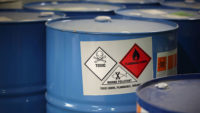Regulation 29 CFR 1910.1200
Key provisions:
To ensure chemical safety in the workplace, information about the identities and hazards of the chemicals must be available and understandable to workers. OSHA's Hazard Communication Standard (HCS) requires the development and dissemination of such information:
Chemical manufacturers and importers are required to evaluate the hazards of the chemicals they produce or import, and prepare labels and safety data sheets to convey the hazard information to their downstream customers;
All employers with hazardous chemicals in their workplaces must have labels and safety data sheets for their exposed workers, and train them to handle the chemicals appropriately.
Hazard classification: Provides specific criteria for classification of health and physical hazards, as well as classification of mixtures.
Labels: Chemical manufacturers and importers are required to provide a label that includes a harmonized signal word, pictogram, and hazard statement for each hazard class and category. Precautionary statements must also be provided.
Safety Data Sheets: Have a specified 16-section format.
Information and training: Employers are required to train workers on the label elements and safety data sheets format to facilitate recognition and understanding.
An evaluation of chemical hazards must be performed considering the available scientific evidence concerning such hazards. The hazard determination provisions have definitions of hazard and the evaluator determines whether or not the data on a chemical meet those definitions. It is a performance-oriented approach that provides parameters for the evaluation, but not specific, detailed criteria.
The hazard classification approach has specific criteria for each health and physical hazard, along with detailed instructions for hazard evaluation and determinations as to whether mixtures or substances are covered. It also establishes both hazard classes and hazard categories—for most of the effects; the classes are divided into categories that reflect the relative severity of the effect. Additional health hazard information can be related to the appropriate response to address the hazard.
Resources
1. Joint PHMSA OSHA Memorandum on Labeling of Hazardous Chemicals for Bulk Shipments [PDF].
2. Joint OSHA/PHMSA Memo
3. December 1st, 2013 Training Requirements for the Revised Hazard Communication Standard. OSHA Fact Sheet DSG FS-3642
4. Hazard Communication: Hazard Classification Guidance for Manufacturers, Importers, and Employers. OSHA Publication 3844
5. Hazard Communication: Small Entity Compliance Guide for Employers That Use Hazardous Chemicals. OSHA Publication 3695
6. Hazard Communication Standard: Safety Data Sheets. OSHA Brief DSG BR-3514
7. Hazard Communication Standard: Labels and Pictograms. OSHA Brief DSG BR-3636
8. Hazard Communication Standard Final Rule. OSHA Fact Sheet.




